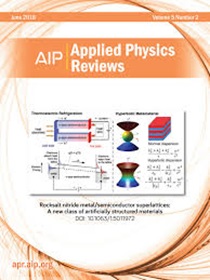超润滑剂滑动铁电性
IF 11.6
1区 物理与天体物理
Q1 PHYSICS, APPLIED
引用次数: 0
摘要
非对称范德华界面处的结构超润滑导致了超低摩擦系数。在本研究中,我们尝试采用类似的策略来减少具有相应界面的范德华双层/多层中滑动铁电性的障碍,因为在这种减少之后,铁电存储器中的写入速度将几乎呈指数级提高。一个主要的挑战是不相称的界面通常是非铁电的,我们的解决方案是不对称的跨层堆叠。我们提出了一种由异质层隔开的均匀层中的超光滑滑动铁电,其中极化源于跨层相称堆叠构型的对称破缺。同时,相邻层的界面不相称导致了前所未有的低开关势垒。例如,如果3R双层MoS2被石墨烯或BN单层分开,它们的开关势垒将分别降低约两个或一个数量级(0.027和0.167 meV/原子),并且开关所需的电压可以降低约一个数量级。这种超润滑滑动铁电广泛存在于各种类似的三明治三层体系中,其中跨层堆叠构型引起的对称破缺也可能导致相当大的极化。与普遍的铁电体相比,由于开关势垒降低了3 - 4个数量级,具有划时代意义的应用,如超润滑油纳米发电机和皮秒铁电体,可能变得可行。本文章由计算机程序翻译,如有差异,请以英文原文为准。
Superlubric sliding ferroelectricity
Structural superlubricity at incommensurate van der Waals interfaces leads to ultra-low friction coefficients. In this study, we try to apply a similar strategy to reduce the barrier of sliding ferroelectricity in van der Waals bilayers/multilayers with commensurate interfaces, since the writing speed in ferroelectric memories would be enhanced almost exponentially upon such reduction. A major challenge is that incommensurate interfaces are generally non-ferroelectric, and our solution is asymmetric across-layer stacking. We propose a type of superlubric sliding ferroelectricity in homobilayers separated by a hetero-layer, where the polarizations stem from symmetry breaking in across-layer commensurate stacking configurations. Meanwhile, the incommensurate interfaces of adjacent layers lead to unprecedented low switching barriers. For example, the switching barrier of 3R bilayer MoS2 will be, respectively, reduced by around two or one order of magnitudes (0.027 and 0.167 meV/atom) if they are separated by a graphene or BN monolayer, and the required voltage for switching can be about one order of magnitude lower. Such superlubric sliding ferroelectricity widely exists in various similar sandwich trilayer systems, where symmetry breaking induced by across-layer stacking configurations may also lead to considerable polarizations. With switching barriers three–four orders of magnitude lower compared with prevalent ferroelectrics, epochal applications, such as superlubric nanogenerators and picosecond ferroelectricity, may become feasible.
求助全文
通过发布文献求助,成功后即可免费获取论文全文。
去求助
来源期刊

Applied physics reviews
PHYSICS, APPLIED-
CiteScore
22.50
自引率
2.00%
发文量
113
审稿时长
2 months
期刊介绍:
Applied Physics Reviews (APR) is a journal featuring articles on critical topics in experimental or theoretical research in applied physics and applications of physics to other scientific and engineering branches. The publication includes two main types of articles:
Original Research: These articles report on high-quality, novel research studies that are of significant interest to the applied physics community.
Reviews: Review articles in APR can either be authoritative and comprehensive assessments of established areas of applied physics or short, timely reviews of recent advances in established fields or emerging areas of applied physics.
 求助内容:
求助内容: 应助结果提醒方式:
应助结果提醒方式:


